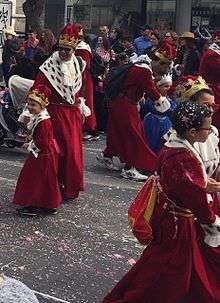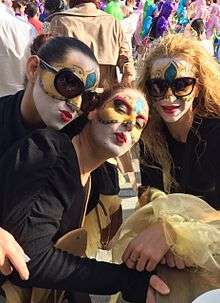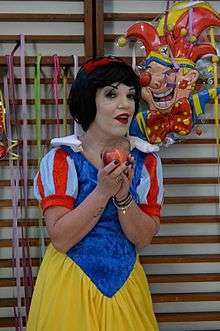Limassol Carnival Festival
The Limassol Carnival Festival is an annual European carnival event held at Limassol, Cyprus. It is considered one of the most notable carnival events worldwide.[1][2][3][4][5][6][7][8][9] The event is held 12 days before the Christian season of Lent on the Sunday before Ash Monday, 50 days before Orthodox Easter.[10][11] The festival is a 10-day colourful event of people feasting, singing songs, satire, games, carnival processions and balls.[12][13][14]
| Limassol Carnival Festival | |
|---|---|
.jpg) Grand Carnival Parade of Limassol | |
| Official name | Limassol Carnival |
| Also called | Karnavali Lemesou |
| Observed by | Europeans & non-Europeans |
| Significance | Social, Religious, Economic |
| Celebrations | Costume Parties & Parades |
| Date | Sunday before Ash Monday |
History
.jpg)
Limassol Carnival Festival, which is said to be an old custom traced to pagan rituals,[15] is now held as an entertaining event.[16] The local belief is that it is a Hellenistic heritage that goes back to pre-Christian times and to an ancient Greek festival honoring Dionysus, the deity of wine and fun. However, the first written reference of the carnival is by Nеоphitos Egklistos, who accuses Cypriots of idolatry and accepting an alien tradition of celebrating the start of the Great Fast. The second historical mention is from Christophor Furkher Nirenberg, whо visited Cyprus in 1566 during a journey to the Holy Land. Nirenmberg was impressed by the carnival parades and told a story about how local noblemen organize amazing feasts, where people dance, sing and have fun.[17] As practiced now in Limassol is a legacy from the Venetians who ruled over Cyprus during the 15th–16th centuries.[16][18][19] The Carnival of Venice, however, takes itself very seriously, in comparison. In contrast, both adults and children can join the Limassol Carnival and as a rule everyone pours foam on each other in the Old City. The celebrations are held in most towns around the island, but the event held in Limassol is by far the largest and most popular.[11][19]
Social Importance

As an institution and traditional festival, the Carnival has been celebrated consistently in Limassol and all over Cyprus over the last one hundred years, and regardless of political or economic conditions it represents a ritual which on the eve of spring affords the opportunity for people to express their faith and optimism for a good year.[20] The municipality conducts a minimum of five masked balls which include an open-air ball on Heroon Square in the heart of city center, and in huge ball rooms of major hotels. A children’s parade is rightly considered to be one of the key events of the carnival. It is held on the first Sunday of the festive events. Children customarily dress up in carnival costumes and travel the streets of Limassol.
On the Grand Carnival parade the floats theme and the singing are commonly satirical. The Carnival King or Queen could be presented as a satirical figure representing social, political and economic conditions of relevance to Cyprus or Europe in general. On the final day which is the Grand Carnival more than 150 floats and an estimated 50.000 people take part in the procession. The city's brass band and groups of drummers and mandolin-toting kantadoroi (serenaders) accompany the Carnival King (or Queen). During 2014 the satirical theme was the Carnival King depicted with Euro signs indicative of the economic crisis in Europe. On an earlier occasion the Carnival Queen was presented as Angela Merkel as they had then considered her responsible for the economic crisis in Cyprus.[16]
Themes & Timeline

- The first week of the festival begins on a Thursday with entry of the King Carnival (as a satirical display it could be a Queen also[16]) in a procession through the town which is decorated for the occasion followed by a grand fancy dress competition of children that is held at the Tsirion Athletic Stadium. The first week also marks the Meat Week (Kreatini), which is the last week for eating meat before Easter. The day the festival starts is also known as "Tsiknopempti" (meaning "Stinky Thursday"[16]), a name attributed to the cooking aromas of meat pervading the streets.[18][19][21]
- In the second week of the festival, which is called the cheese week (Tyrini), dairy products are consumed. At the end of the week on a Sunday the celebration involves the Grand Carnival parade which is taken through the Makariou III Avenue of Limassol. People from all parts of the island gather to watch the "floats with the serenade and other masqueraded groups."[18][19]
- Throughout the festival period most hotels and clubs in the city hold fancy dress balls and parties.[18] Clowns, cowboys, pirates, dragons, ancient Greeks and medieval knights are popular themes, but pop stars along with characters from the year's hit movies and musicals are also a common sight.[22]
Location
The Limassol Municipality organizes the final Carnival Grand Parade all the way through the Makarios Avenue (approximately 7 kilometers), Limassol's high street.[23][24]
2016 Rules
After some groups broke the ground rules in 2015, the Limassol municipality does not allow offending groups or floats from starting from the Enaerios junction and may intercept them at a later stage with the help of police and security guards.[25] The new rules are as follows:
- The number of participants in each group should not exceed 500 people
- Large amount of alcohol is not allowed on the floats
- No DJ is allowed on board the vehicles
- Broadcasting music is forbidden
- Loudspeakers must be tuned into the radio frequency broadcasting music for the parade
Random Street Images
See also
References
- "Carnival parade held in sea-side city of Limassol". 2016-03-14. Archived from the original on 2018-12-27. Retrieved 2018-12-27.
- "The Carnival is a great popular festival which has been celebrated in Limassol and all over Cyprus for more than a hundred years". Archived from the original on 2016-04-05. Retrieved 2016-04-05.
- "Limassol Carnival Parade – Limassol, Cyprus : World Festival Directory". 2014-06-12. Archived from the original on 2020-03-01. Retrieved 2020-03-01.
- "Cyprus in March..." 2013. Archived from the original on 2016-04-03. Retrieved 2016-04-03.
- "Limassol Carnival". www.ft.com. Retrieved 2020-03-01.
- "In Cyprus, the best Carnival outside of Rio". 2014-03-04. Archived from the original on 2020-03-01. Retrieved 2020-03-01.
- "Carnival around the world". NBCNews.com. Archived from the original on 2019-04-10. Retrieved 2020-03-01.
- "Photos of the Day: March 13, 2016". The Seattle Times. 2016-03-13. Archived from the original on 2020-03-01. Retrieved 2020-03-01.
- Gauldie, Robin (2014-03-03). "Limassol Carnival is the most colorful event on Cyprus". CNN. Archived from the original on 2020-03-01. Retrieved 2020-03-01.
- Merin & Burdick 1979, p. 82.
- Antoniadou 1992, p. 47.
- My Destination: Limassol Carnival
- "Cyprus Festivals & Annual Events". carnaval.com. Archived from the original on 2020-03-01. Retrieved 2020-03-01.
- "5 Reasons Why Limassol Carnival Is King!". Archived from the original on 2016-05-26. Retrieved 2016-05-26.
- "Limassol Marathon Cyprus". cyprusmarathon.tumblr.com. Retrieved 11 January 2016.
- "Limassol, Cyprus: Coolest Carnival outside of Rio?". CNN. 3 March 2014. Retrieved 1 December 2015.
- Limassol Carnival: The History of the Festival From Ancient Times to the Present
- Inc 2012, p. 101.
- "Limassol events". Cyprus Event News. Retrieved 24 November 2015.
- Limassol Municipality: Carnival
- Limassol carnival set to be 'biggest ever'
- CNN: Limassol, Cyprus: Coolest Carnival outside of Rio?
- "Limassol Carnival". Limaol Municipality. 2015.
- Go fashion shopping on Limassol’s Makarios Avenue
- Limassol carnival to get stricter on floats and groups
Bibliography
- Inc, IBP (3 March 2012). Cyprus Country Study Guide Volume 1 Strategic Information and Developments. Lulu.com. ISBN 978-1-4387-7423-7.CS1 maint: ref=harv (link)
- Antoniadou, Zoe Andrea (1992). The Gradual Destruction of the Urban and Cultural Environment in Limassol, Cyprus. University of California, Berkeley.CS1 maint: ref=harv (link)
- Merin, Jennifer; Burdick, Elizabeth B. (1 November 1979). International directory of theatre, dance, and folklore festivals: a project of the International Theatre Institute of the United States, inc. Greenwood Press. ISBN 978-0-313-20993-2.CS1 maint: ref=harv (link)
